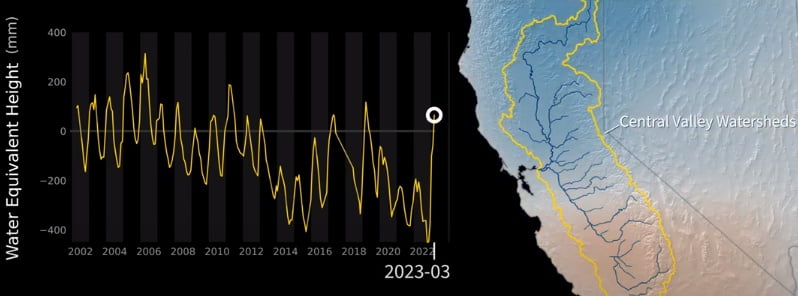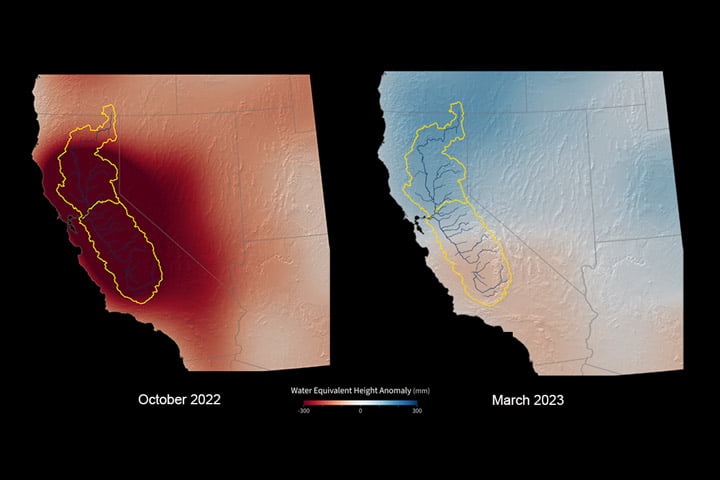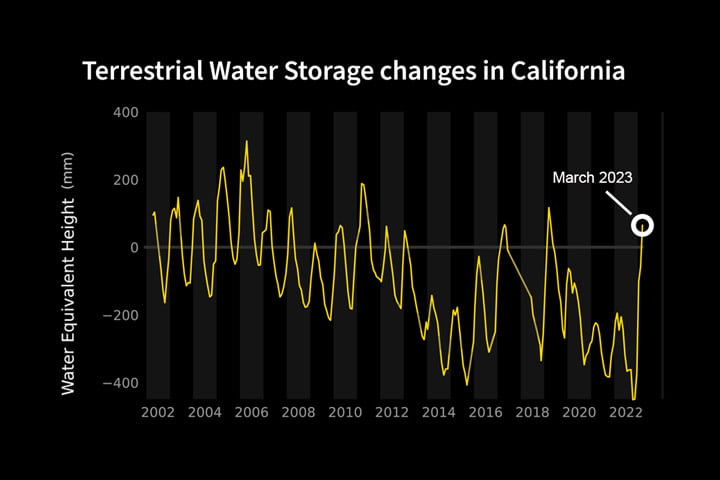Revival of California’s water: Satellite data reveals record gains

California, under the grip of intense drought for years, experienced its highest year-over-year water gains in the last two decades, as revealed by the GRACE-FO satellite mission, a collaborative initiative between NASA and GFZ. Between October 2022 and March 2023, the state received sufficient rainfall to increase the water levels by approximately 50.8 cm (20 inches), roughly twice the average winter water gain since 2002.
After a prolonged period of severe drought and depleting groundwater levels, California finally saw a ray of hope. The Gravity Recovery and Climate Experiment Follow-On (GRACE-FO) satellite mission, a joint venture between NASA and the German Research Centre for Geosciences (GFZ), reported that the state had witnessed its largest year-over-year water gains in two decades.
The state’s Central Valley region, considered a gigantic swimming pool, was a key focus of the GRACE-FO measurements. The data took into account all the water contained in the region’s lakes, rivers, soil, snowpack, and underground aquifers. The period from October 2022 to March 2023 saw storms providing enough water to elevate the water quantity within this “swimming pool” by an impressive 50.8 cm (20 inches). This figure stands as approximately twice the average winter water gain since the inception of satellite-based water storage measurements in 2002.
The water gain from October 2022 to March 2023 period is visually represented in the maps below. The blue colors designate areas that experienced above-average wetness (relative to 2004–2010), while the red colors indicate areas that were drier than average.




Despite the promising increase in surface water basins, the underground reservoirs of fresh water, or aquifers, which are crucial for irrigation and other needs, could require several more years to recharge fully. Felix Landerer, GRACE-FO project scientist at NASA’s Jet Propulsion Laboratory, warns that “One good winter of rain and snow won’t make up for years of extreme drought and extensive groundwater use”.
The GRACE-FO team is committed to monitoring the evolution of California’s water storage, particularly during the summer months, when the snowpack melts and water levels in the state’s lakes, rivers, and reservoirs are expected to decrease due to drier weather conditions.
The ground-breaking observations were made feasible by the unique sensing approach utilized by both GRACE missions. As water moves around in various forms, such as ocean currents, rainfall, shifting groundwater, ice, etc., it alters the planet’s mass near the surface, thereby minutely changing Earth’s gravitational pull. The GRACE-FO measures these subtle changes, allowing researchers to estimate the changes in the total volume of water in an area.
References:
1 Satellites Show Gains in California Water – NASA/Earth Observatory – June 10, 2023
Featured image credit: NASA/JPL-Caltech


Commenting rules and guidelines
We value the thoughts and opinions of our readers and welcome healthy discussions on our website. In order to maintain a respectful and positive community, we ask that all commenters follow these rules.